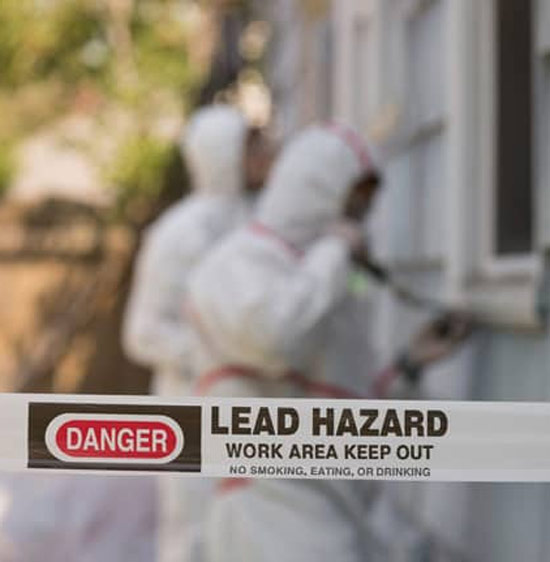Trusted DOH & HPD Lead Violation Removal in NYC-- Shield Your Residential or commercial property
Comprehensive Guide on Effective Lead Infraction Removal Strategies
In the realm of ecological safety and security, addressing lead violations requires a thorough and structured strategy. This detailed guide starts by highlighting the essential first actions of identifying lead threats via innovative assessment and testing methods. Techniques such as XRF analysis and dust clean sampling are crucial in identifying contamination resources. Moreover, the overview specifies on the significance of adhering to strict safety and security methods throughout the elimination procedure, including making use of correct PPE and isolating affected areas (Lead Paint Removal Company). The succeeding areas promise to go over post-removal confirmation and preventative approaches, making certain long-lasting safety and conformity. Discover the complex details that make these methods not simply effective but important.
Recognizing Lead Dangers
Recognizing lead hazards is a vital very first step in mitigating the threats linked with lead exposure. Lead, a hazardous steel, can be present in numerous environmental tools, including paint, soil, water, and dirt.
The initial phase in identifying lead risks includes comprehending typical lead sources within the developed setting. Structures constructed before 1978 are specifically at risk as a result of the widespread usage of lead-based paint throughout that duration. In addition, soil contamination can occur from weakening exterior paint, commercial emissions, or historical usage of leaded fuel.
One more considerable source is lead piping and pipes fixtures, which can leach introduce drinking water. Customer goods such as toys, ceramics, and imported products might additionally contain hazardous lead degrees. Especially, occupational atmospheres and leisure activities entailing lead can track contaminants right into homes.
Analysis and Testing
When resolving lead threats, effective analysis and testing are paramount. This vital action ensures the identification and metrology of lead existence, thereby guiding succeeding remediation initiatives. First analysis commonly includes a visual examination to recognize potential lead resources, such as weakening paint or infected dirt. This is matched by more extensive screening techniques to identify the degree of contamination.

Dirt clean tasting is another crucial technique, specifically in domestic setups. By collecting examples from floorings, windowsills, and various other surface areas, this approach supplies insights into potential direct exposure risks. Dirt screening around structure borders is vital to find lead contamination that might posture risks, specifically to youngsters.
Safe Removal Procedures
Upon finishing thorough evaluation and screening, carrying out safe removal procedures is the following important stage in resolving lead risks. This process makes sure that lead-contaminated materials are properly and safely eliminated, lessening danger to both workers and homeowners. The very first step involves separating the affected location see here utilizing plastic sheeting and proper sealing techniques to protect against the spread of lead dirt.
Employees need to wear proper personal safety devices (PPE), consisting of respirators, gloves, and disposable coveralls, to reduce exposure. Utilizing specialized devices and damp techniques, such as damp fining sand or making use of HEPA-filtered vacuum cleaners, decreases the dispersion of lead fragments. It is critical to avoid completely dry sanding or rough blowing up, as these approaches can generate harmful lead dirt.
Garbage disposal is one more crucial component; all infected products have to be safely bagged and classified according to EPA and regional policies. Furthermore, detailed cleaning of the workspace with HEPA vacuums and damp cleaning ensures the elimination of residual lead particles.
Post-Removal Confirmation

Verification of successful lead elimination, known as post-removal verification, is imperative to make certain the safety and security and habitability of the remediated location. This inspection ensures that all known resources of lead have been resolved and that no noticeable indicators of contamination continue to be.
Following the visual inspection, environmental sampling is conducted. This includes gathering dirt, soil, and often water examples from the remediated location. Recognized labs analyze these samples to determine lead levels, guaranteeing they drop listed below the safety thresholds established by governing bodies such as the explanation Environmental Security Firm (EPA)
Furthermore, air high quality screening might be executed to spot airborne lead fragments, specifically in situations where substantial lead-based paint elimination or improvement has actually occurred. The results of these examinations offer measurable data confirming that the lead degrees are within allowable limitations.
Inevitably, post-removal verification serves as an important checkpoint, confirming the performance of the lead abatement efforts and guarding the health of passengers and visitors.
Safety Nets and Maintenance

A crucial safety net consists of making use of lead-safe licensed contractors for any type of remodelling, repair work, or painting tasks. These professionals are learnt techniques that reduce special info lead dirt and particles. In addition, maintaining painted surface areas to prevent cracking or peeling off is vital, as wearing away paint can launch lead bits into the atmosphere.
Educational campaigns targeting building proprietors and renters pertaining to the risks of lead and the value of reporting any kind of potential threats can even more enhance preventive initiatives. Routine cleansing using HEPA vacuum cleaners and damp mopping techniques can significantly decrease lead dirt buildup.
Conclusion
In summary, reliable lead offense removal requires a thorough method incorporating thorough assessment, specific screening, and rigorous removal treatments. Making sure safety through proper seclusion and personal safety equipment remains paramount. Post-removal verification by means of environmental sampling and air quality testing validates conformity with well established security standards. Additionally, continuous evaluations and maintenance are important to mitigate future lead hazards, therefore guarding public wellness and making sure sustained conformity with governing requirements.